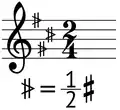The sori (Persian:سری) is a symbol that corresponds to a quarter step higher in tone in Persian traditional music.[1] It is written as a ">" sign, crossed by two vertical lines, and can be used like an accidental.
In the early 20th century, Iranian master musician Alinaghi Vaziri established this sign for the sori for use in written Persian music using standard western notation.[2] Character representation of this accidental symbol together with Koron[3] encoding (encoded as U+1D1E9 and U+1D1EA) microtones used in modern Iranian classical music added to the Unicode standard[4] in Version 14.0.0.[5]
 Sori used in musical notation
Sori used in musical notation
See also
External links
- Persian accidentals in the SMuFL glyph (Standard Music Font Layout)
References
- ↑ Mohajeri, Shaahin. "About 24-EDO". 96edo.com. Archived from the original on 22 September 2020.
- ↑ Pirnazar, Maryam (16 July 2013). "Reza Vali: An Iranian Composer to Watch and - of course - to Hear". payvand.com. Payvand.
For transcription of the micro-tones, I use the standard notation of the micro-tones, the Sori and the Koron, which were developed during early 20th century by the Persian master Alinaghi Vaziri.
- ↑ Pournader, Roozbeh (23 April 2020). "Proposal to encode two accidentals for Iranian classical music" (PDF). unicode.org. Unicode Consortium.
- ↑ "The Unicode® Standard Version 14.0 – Core Specification" (PDF). unicode.org. Unicode Consortium. September 2021.
- ↑ "Musical Symbols - Range: 1D100–1D1FF" (PDF). unicode.org. Unicode Consortium. 2021.
This article is issued from Wikipedia. The text is licensed under Creative Commons - Attribution - Sharealike. Additional terms may apply for the media files.
